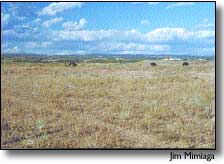|
Oct. 5, 2000 By Jim Mimiaga
A controversial zoning proposal that would have paved the way for a high-density housing subdivision just outside the Cortez city limits was sent back to the drawing board by the Montezuma County Commission on Monday because it was considered incomplete. Developer Don Etnier, representing landowner Eva Bella Hooten, requested an Urban Services Zone designation from the county to develop eight homes on four acres within a 150-acre parcel bordered by County Road L on the north, the posh Rolling Hills neighborhood on the east, Animas Street to the south and rural county homes to the west. An Urban Services Zone is a designation tailored for county development adjacent to city limits in that it conforms with city street and drainage codes and is near sewer and water hook-ups. The Hooten parcel has sewer and water access, but no road through it. Proposed access would be from County Road L via extending Animas Street east and then building the road north to connect with CR L. But Etnierís plan to eventually construct 16 homesites on eight acres in the midst of a scenic meadow has drawn complaints from neighbors and the city of Cortez. And the commissioners were hesitant to approve high-density zoning until a development plan for the rest of the large parcel was submitted. Commissioner Gene Story likened Etnierís proposal to an attempt to get a variance from the land-use code by veiling the development project as a zoning request. "We are certainly moving away from exemptions," Story said. "We want to see a plan for the entire property, not just plucking 2-4 acres right out of the middle for a UBZ zone." "Creating a little zone leaves a large void as to what the development of the surrounding area is going to be, and we do not want to create something here that is not compatible with what is coming down the road," he said. Typically, said county planner Karen Welch, a zoning request is accompanied by a development plan to match, which was not done in this case. A group of neighbors showed up to contest the zoning request after it was passed on to the commissioners by the county planning commission, who voted 2-1 last Thursday recommending it be approved. Concerns about the development included the disturbance of wetlands on the property, utility access, types of housing, traffic impacts on Animas Street and the need to insure a buffer zone between more rural, county homes and higher-density neighborhoods. "I am concerned with the lack of a transition zone between less dense neighborhoods and higher density ones," said Robert Laitsch, an adjoining landowner. "A high density zone may set the tone for the entire area. Given the types of homes that adjoin the property, it is incumbent on the developer to preserve the same character," with a transition. Residences east of the Houghton parcel are preference-zoned AR 3-9 acres, which does not necessarily fit with higher-density developments. But Etnier, who typically builds low-income developments using manufactured or mobile homes, has argued that his plan does fit with similar home sites on Animas Street and the nearby San Juan Park development. The site falls within a so-called "urban influence zone," or any area that borders Cortez and the county line. Planners from both governments have agreed to coordinate development on either side so that they match up. That also makes it easier for a city to annex the community it if chooses to later on. "The city needs to be in agreement, so we need to sort out what their issues are," Story said. The area around Animas Street is currently zoned as R-1, or "stick-built," single-family zones, although there are some manufactured and mobile homes in nearby Cornett Heights. "If it is going to be located within the one-mile area, then it was a consensus that it should be up to city standards," said Cortez City Manager Hal Shepherd. "We wouldnít recommend access off of Animas Street because it needs to be improved before more traffic is on it ó paved, curb and gutter and sidewalks. Without being paved, the added impacts would mean a lot of dust for those residents. "He could build in from CR L, without a connection to Animas," he said. "In todayís age we need to have a more thorough development plan. You canít put something in and then expect to tack on something later." Neighbor Bruce Newton worried about the increased traffic. "(The proposal) would dump even more traffic on to Animas Street, and that street canít handle it as it is now," he saiud. Cortez Planning Intern Drew Nelson said the subdivision would add 56 vehicle trips per day to Animas Street. "I know they do not want it," said Etnier. "But I donít see how they can prevent it when (the Animas Street extension) is on the Master Street Plan." Beyond informing urban and county planners of what the overall plan is for the rest of the property, Etnier must also obtain permits from the Army Corp of Engineers before building an access road across identified wetlands on the property. Finding a suitable spot for low-income housing projects has been troublesome for Etnier. Last year a proposal to construct manufactured homes within the city limits near his current proposal also drew adamant opposition from neighbors and was ultimately denied by the city council. "I do not have any trouble right now with putting the whole property as an Urban Service Zone," commented Commissioner Kelly Wilson, "but I would like to see how it would all tie in. "I donít feel comfortable taking a chunk out" and zoning just that, he said. |
||||
|
Copyright © 2000 the Cortez Journal.
All rights reserved. |
